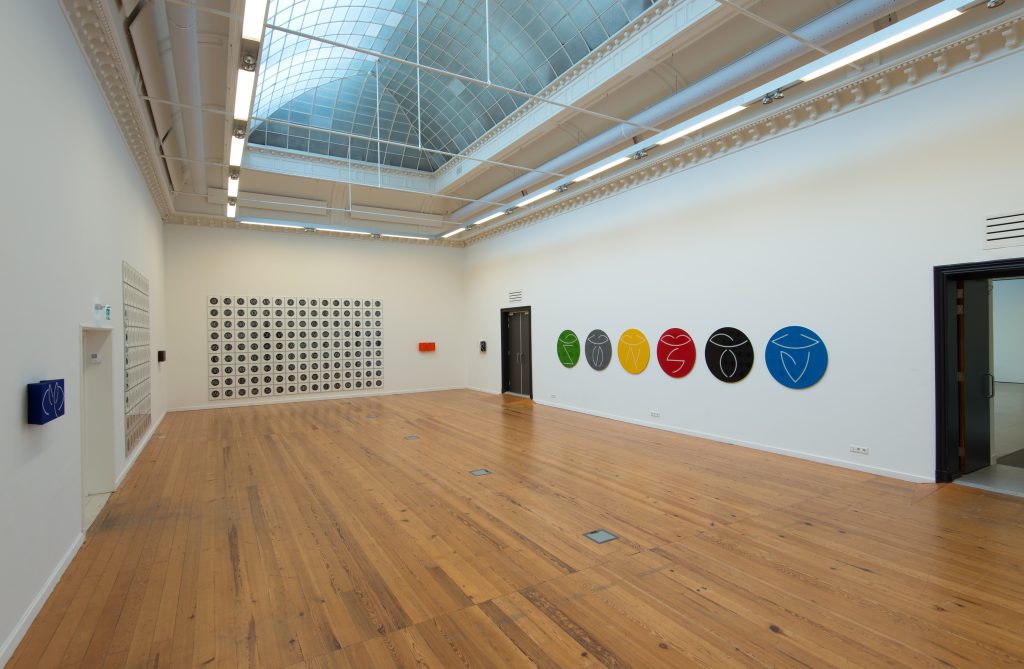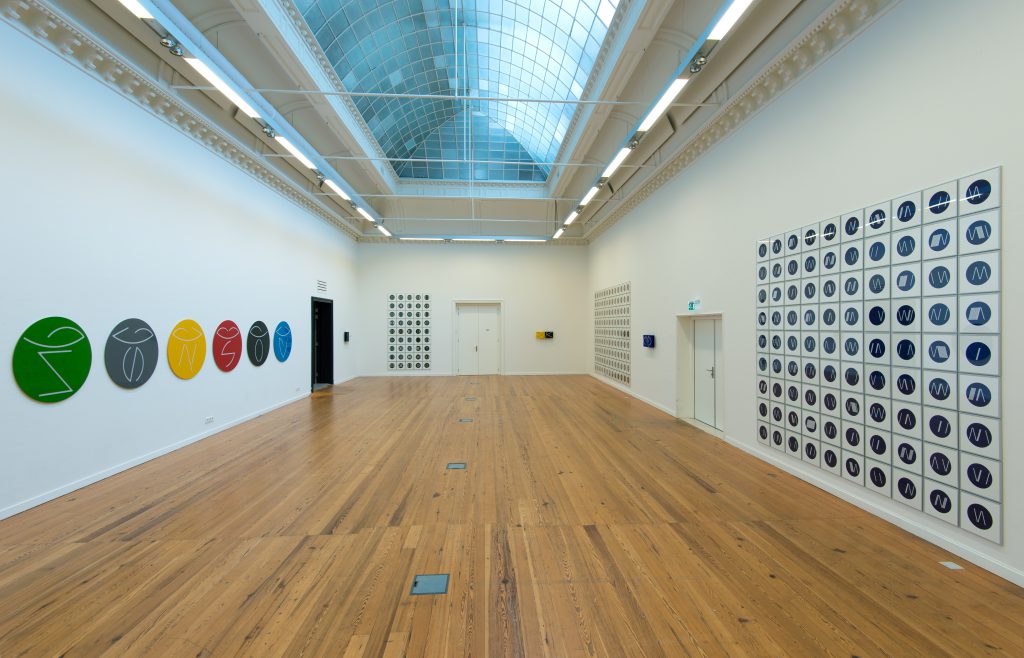Exhibition Circumvolution at the Academy of Fine Arts Minerva, Groningen (NL), 2015.
Review by Jenny Wilson
Ton Mars, Circumvolution
Circling with lines in invisible spirals
Walking into Minerva’s Koepelzaal feels like a crisp, serene, almost sacred experience. The space would be empty if it weren’t for the artworks on the wall. Four imposing, tightly ordered grids, each packed with an expansive series of silver-framed square works featuring circles containing signs. The large grids are interspersed with small, mostly brightly coloured, rectangular canvas diptychs that triangularly protrude from the walls; their flat outward surfaces simultaneously forming the painterly surface. These angular works are in turn offset by a series of six large circular works displayed in a horizontal line, also containing signs.
The signs are variations of straight lines and curves, dancing within the works yet neatly contained. Square, rectangle, circle. Circles within squares, lines and/or curves within circles. Rectangular canvases playing with the notion of the object, the sculpture. Shiny painted glass spheres playing with the notion of ‘tondi’, the Renaissance term for circular artworks.The works emit a language that could be mistaken for sci-fi coding or alien runes if it weren’t for an earthy element of the hand-of-the-maker, clearly evident upon closer inspection. Seeming rigidity is juxtaposed with an attentive feel for material.
A monastic quality of concentration is at play. The diptychs’ Latin series title, AB UNO / AD UNUM, refers to ‘single’ and ‘one’, alluding to a studied game of stripping down – image as well as language. The accompanying exhibition text provides an essential insight into how to ‘read’ the diptychs. There is a system. Everything is brought back to ONE. The word ‘one’ has been translated into various Eurasian, African and Native American languages. From which these works take their cue, their colours referring to the respective continent. And yet, a sense of perplexity remains. Mars’ play with association is also one that is left hanging, suspended somewhere between image and language, between registration and comprehension. It is an intuitive, playful, well-considered system that confronts the essence of what visual language is and can be.
The works also demonstrate an acute awareness of art history. There’s an unmistakable nod to Mondrian, of stripping back the image whilst maintaining a visceral tangibility. And the diptychs occasionally feature a reddish-orangey outline to lead and hold the viewer’s gaze, a technique appropriated from classical Italian painting. The four Radical Expansions play with blending techniques reminiscent of ‘sfumato’. And at the same time, the signs bring to mind a deconstructed binary code of zeros and ones.
On this scientific note, the Radical Expansions contain small tondi evocative of petri dishes spawning signs. The visual backbone of Mars’ oeuvre, the ‘stem signs’ remains evident throughout, yet these works embody an organic quality of movement, mutation and restructuring. Your eye darts from one tondo to the next. Each brimming with lines and/or curves, contained yet deceptively multiplying before our very eyes. With titles such as: No. II (Red – The Conditioning Name) and No. VI (Grey – The Narrowing Name), the large tondi series, The Initials, dating from 2013 (high gloss paint on Plexiglas), questions the practice of naming. Visual language contemplated, described, and discussed in verbal language, and, of course, given a title: a name. The works’ rounded glass countenances playfully toy with our embedded pre-programming for facial recognition. To put a face to a name or a name to a face, as it were.
The geographical, biological, and spiritual references Ton Mars utilises explore polarities that add up to a circular context that spirals into places unknown. Nothing is fixed, and yet you get the sense that the entirety is contained. Image and language float, not only metaphorically but also physically. His subtle plays with light and shade – evident in the diptychs and tondi which are seemingly removed from the wall – give the exhibition a metaphysical quality. And this is what epitomises Circumvolution: transcendental associative context. Image and language as a mutual means to pin down and at the same time to transcend. Image and language are so interlinked, so interwoven, so interconnected with one another that we can only ever partly deconstruct them to give them a new order. It is a symbiotic relationship Mars does not wish to break, but to explore, to almost pay homage to. The exhibition in the celestial space of De Koepelzaal certainly succeeds in this. Not only is it an ode to image and language, its playful spiralling within a game of association is also an ode to the backbone of artistic practice and thought.
Published by Beeldende Kunst en Vormgeving, 13 oktober, 2015.

